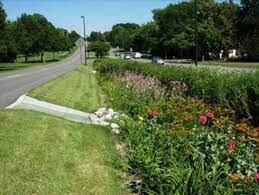Image courtesy of the City of Calgary via trca.ca
Guest blogger: Karina Bree, Program Manager at Sustainable Kingston
A rain garden contains native plants in a small depression to temporarily hold and soak in water after a rainfall. Water is only held for 12-48 hours, so the garden is usually dry and does not promote mosquito breeding. As a bonus, since rains gardens use native plants after the garden is established for a couple of years, they typically do not need additional watering!
Rain gardens are versatile and can be set up so that they collect water, great for areas that collect puddles, or to allow water to slowly run along its length such as rain barrel overflows Both types allow for more water to soak into the ground than a conventional lawn which helps provide stormwater and flood control. Also, they can both remove nutrients, chemicals, and sediment from rainwater runoff which improves water quality.
Image Source:Utilities Kingston
Image Source: wolfeboronh.us
To give you an idea of the impact, let’s look at Kingston. Kingston has 1102 mm of rainfall per year. This means that a 5m2 rain garden in Kingston would have 5.51m3, or 1455.59 gal, of rainfall per year. If the City had to treat the water, it would take about 93.22 kWh to process. Assuming the rain garden fully diverted the water from entering the treatment process 0.0028 tCO2e would be reduced per garden.
Image Source:Utilities Kingston
Interested in starting your own rain garden? Here are some things to consider:
Where is the water coming from? Also known as the catchment area(s) this could include rooftops, surrounding landscapes or a combination
What is the land like? A soft landscape has grass and gardens to slow the flow of water while a hard landscape has fast runoffs; sandy soil will dry faster than clay-based soil, and shallow bedrock will not work for infiltration rain gardens.
Where will the garden be placed? A site with gentle slopes is ideal for a rain garden, although a flat site will also work. Make sure there is enough space to accommodate the garden, and space for an overflow area in case of storms. Don’t forget to check your location for utilities!
What is your maintenance budget? Gardens are never finished, but rain gardens have a few extras to consider for maintenance, such as keeping outflow pipes unclogged or dredging accumulated sediment from the basin.
Check out the Groundwater Foundation, Utilities Kingston, or Rideau 1000 Islands Master Gardeners to learn more!
Want to see the process before getting started? No problem! As part of the Climate Action Fund, Sustainable Kingston is partnering with Kingston Frontenac Housing Corporation to implement a rain garden at four locations this spring. We'll share the process with a blog post once it’s finished!




